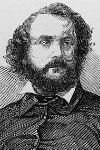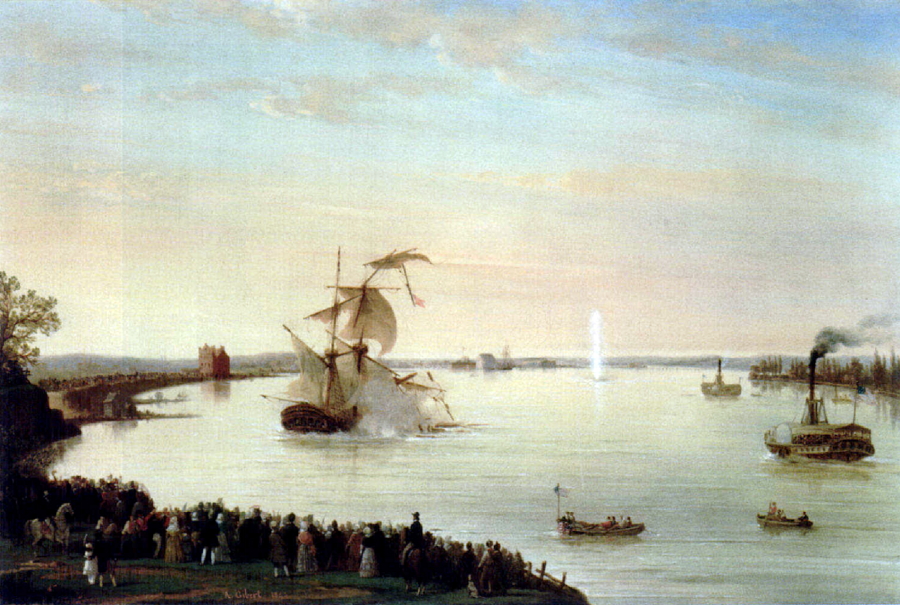 Last week, I wrote about Samuel Colt and his destruction of a ship in the harbor of New York, without ever referring to Capitol Hill. Today, I tell the second half of the tale, and how it does, indeed, relate to our neighborhood.
Last week, I wrote about Samuel Colt and his destruction of a ship in the harbor of New York, without ever referring to Capitol Hill. Today, I tell the second half of the tale, and how it does, indeed, relate to our neighborhood.
Having proved the concept of his mines, it was now time for Samuel Colt to make them work in practice –particularly in making sure that the charge was directly underneath the ship when it went off. Colt’s idea was to place a whole array of explosives underwater, and then have shore-based observers touch off the charge closest to the ship under attack. In order to make this feasible, he needed money. And so, he headed to Washington and to the government money that would turn his plan into reality.
Colt had one great problem in this regard: He was almost pathologically secretive, and unwilling to divulge even the least bit about his ideas for fear that they would be stolen. This dramatically limited people’s willingness to give him money, for obvious reasons.
Nonetheless, Colt managed to scrape together enough to make one demonstration of his improved system on the Anacostia. The basic idea was simple: put down an array of mines, each at the intersection of two wires that stretched across the river and then connected to one of two observers who sat some distance from one another. When the ship crossed one of the wires, the observer would connect his end to the battery, while the other observer connected his end to ground. If the two observers connected their wires simultaneously, the charge at the intersection of these two wires –i.e., the one directly under the observed ship– would go up and take out the ship… or so was the plan. Whether it would work in practice, particularly after a number of the charges had gone up, was another question.
On April 12, 1844, the Whig Standard published a short piece indicating that Colt’s experiment would “take place to-morrow evening at half-past 4 o’clock, in the Eastern Branch, between the Arsenal and the Navy Yard.” The experiment would see if a “large, full-rigged vessel, with sails set, of 500 tons burden” could be sunk.
Three days later, the same paper reported on the test as it had been performed before “an immense concourse of people of both sexes and of all colors and descriptions.” At 4:30 PM President John Tyler appeared, welcomed by the usual blast of cannons. The doomed vessel, a barque named Styx under the temporary command of a Lieutenant Boyle, was set into motion, and Boyle and his men retreated from the barque in a small boat. The first two explosions, which occurred almost immediately upon the men leaving the Styx, “threw up great quantities of mud from the bottom,” without, however, doing any damage. The third explosion “struck her directly under her foremast, tearing her bow to atoms.” The ship sank immediately, but not very deeply, as the Eastern Branch was not terribly deep at that point.

The Last Experiment of Mr. Colt’s Submarine Battery. 1844 painting by Antoine Placide Gibert. For a long time, this was assumed to be in New York harbor. However, the building to the left of the doomed ship is clearly Coningham’s brewery, and the Washington Navy Yard can be seen to the Styx‘s right. (Google Books)
Boyle and his men reboarded the wreck and raised the US flag they had recently lowered – “probably to indicate to the occupants of the numerous boats in the vicinity that the wreck was not literally public property,” as the Standard put it. The crowd, for its part, dispersed, “appearing fully satisfied with their entire success.”
Unfortunately for Colt, the powers-that-be were much less impressed. In particular, they were unhappy with Colt’s secrecy. Until today, it is unclear how, exactly, Colt timed the explosion under the Styx. Without such data, and the assurance that the system would work as well under the stresses of wartime, there was no way that Colt would be given further money to refine his system.
Instead, Colt soon found himself with a large order from the government of Texas to build his patented revolver, and the development of mines ceased for the time being.
In the end, the much greater impact – at least locally – from Colt’s experiment came from the sunken hulk of the Styx, which, according to Lundeberg was “not fully disintegrated by a subsequent demolition effort and mine-firing demonstration carried out by Colt on 20 April” and “continued to obstruct the narrow approach channel and gradually built up a major sandbar that embarrassed ship movement in and out of the Yard virtually to the eve of the Civil War.”
